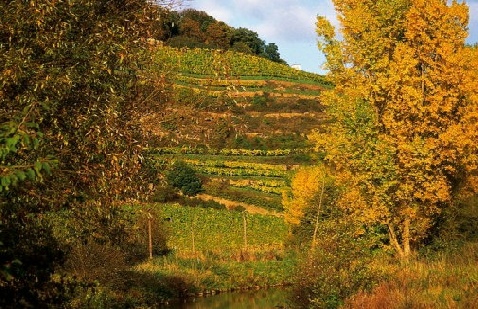© 2000-2015 GermanWineEstates.com Inc.
All Rights Reserved




The Nahe region is named after the river that traverses the valleys of the forested Hunsrück Hills as it gently flows toward Bingen on the Rhine.
It is a peaceful landscape of vineyards, orchards and meadows interspersed with cliffs and striking geological formations. Although the Nahe is one of the smaller German wine regions, its extraordinary range of soil types is second to none. For this reason, the region is able to produce quite diverse wines from relatively few grape varieties. The steeper sites of volcanic or weathered stone, and those with red, clayish slate seem predestined for elegant, piquant Riesling wines of great finesse and a light spiciness, while flatter sites of loam, loess and sandy soils yield lighter, fragrant Müller-Thurgau (Rivaner) wines with a flowery note. The Silvaner grape thrives in a number of soils and produces full-bodied, earthy wines.
Geographical location:
In the Hunsrück Hills between the Rhine and Mosel valleys. Vineyards are on or near the banks of the Nahe River and its tributaries, the Glan and the Alsenz, as well as the streams north and west of Bad Kreuznach (Gräfenbach, Guldenbach, Trollbach and Ellerbach).
Major town(s): the spas Bad Kreuznach, Bad Münster am Stein-Ebernburg, Bad Sobernheim.
Climate:
Mild and balanced, with little frost.
Soil types:
The entire rock cycle of igneous (volcanic), sedimentary (sandstone, clay, limestone) and metamorphic (slate) rocks is present in the Nahe.
Vineyard area (2003):
4,221 ha / 10,430 acres · 1 district · 7 collective vineyard sites · 300+ individual sites
Grape varieties [white 77.3% · red 22.7%] (2003):
Riesling (25.1%), Müller-Thurgau (15.6%), Dornfelder (10.1%) as well as Silvaner, Kerner, Scheurebe, Bacchus and the red varieties Spätburgunder, Portugieser.
Marketing:
A high proportion of the region's wine is sold directly to consumers by individual estates. The portfolio of the world's largest direct marketing winery, WIV in Burg Layen, includes Nahe wine. There are cooperative cellars in Meddersheim and Bretzenheim (the latter receives members' grapes; the wines are produced and marketed by the Mosel's regional cooperatives cellars), but their role in the Nahe is less significant than that of cooperative cellars in other regions (e.g. Baden, Württemberg, Franken).
Signposted routes through wine country:
Nahe-Weinstrasse (driving) · Weinwanderweg Nahe (hiking) · Radweg Nahe (cycling)





